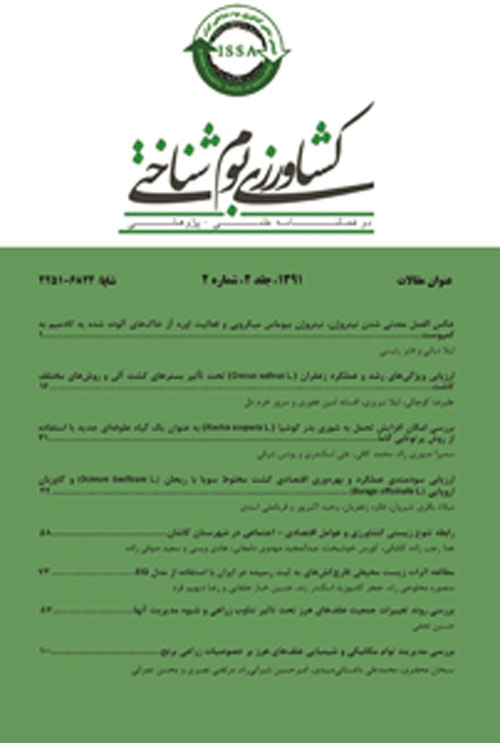Study of field management factors and underlying reasons limiting yield of oilseed rape in east of Golestan province using CPA method
Author(s):
Article Type:
Research/Original Article (دارای رتبه معتبر)
Abstract:
Introduction
Oilseed rape (Brassica napus) is one of the most important oil plants. While a major portion of vegetable oil is needed from outside suppliers, oilseed rape, because of its high yield, can play a critical role in increasing oil and meal production to meet domestic demands. Golestan Province, especially the eastern part, is one of the most important oilseed rape production areas in Iran. The yield of oilseed rape in this region often averages less than 2 t ha-1. The estimation of yield gap and the determination of the responsible factors are a good approach to improve farmers average yield. The present study aims to use the Comparison of Performance Analysis (CPA) method to estimate oilseed rape yield gap in eastern Golestan and to quantify the contribution of each factor to this yield gap in order to reduce yield limitations and improve farmers yield.Materials And Methods
To identify the limitations of production management, this study was carried out in the 2013-14 and 2014-15 growing seasons. The study was executed in Gonbad, Kalaleh and Galikash, the main oilseed rape production areas in eastern Golestan. In the two years studied, 332 farms were evaluated. The study focused on factors of management methods; soil factors were not considered. All data collected on farm management were analyzed for each city and then for the entire surveyed region with stepwise regression and the CPA method (Torabi,et al., 2011; Nekahi, et al., 2014). Thus, yield gap was obtained as the difference between potential yield and the actual average yield of local farmers (Van Ittersum and Cassman, 2013).Results And Discussion
Whilst actual yield was 1,081 in Gonab, 1,456 in Kalaleh and 1,728 kg ha-1 in Galikash, the results showed the attainable yield could have been 3,032, 3,516 and 4,032 kg ha-1 in these areas. Thus, the yield gap was 1,951, 2,060 and 2,304 kg ha-1 . The actual yield in the eastern part of the province was estimated at 1,417 kg ha-1, whereas attainable yield could have been 4,800 kg ha-1, resulting in a yield gap of 3382 kg ha-1. The application of nitrogenous fertilizer was one of the main reasons for yield gap in all the surveyed regions. It reduced yield by 25% in this part of the province. Sulfur fertilizer caused 16 percent of the yield gap. Weeds were the other reason. The lack of weeding was responsible for 16% of the yield gap and the failure to apply Lontrel for the management of weeds for 12%. Disease outbreak was another cause. The application of fungicides offsets 16% of the yield limitation. Seed rate, 6%, and sowing date, 4%, also contributed to the gap. Cultivar and seed treatment were each responsible for less than 2%.Conclusion
Weed management, disease, seeding rate, sowing date, cultivar, and seed treatment, were the main causes of yield gap. Therefore with better management and optimal use of nitrogen and sulfur applications, oilseed rape yield can be increased by as high as 3,382 kg ha-1.Keywords:
Language:
Persian
Published:
Journal of Agroecology, Volume:7 Issue: 2, 2018
Page:
46
magiran.com/p1788033
دانلود و مطالعه متن این مقاله با یکی از روشهای زیر امکان پذیر است:
اشتراک شخصی
با عضویت و پرداخت آنلاین حق اشتراک یکساله به مبلغ 1,390,000ريال میتوانید 70 عنوان مطلب دانلود کنید!
اشتراک سازمانی
به کتابخانه دانشگاه یا محل کار خود پیشنهاد کنید تا اشتراک سازمانی این پایگاه را برای دسترسی نامحدود همه کاربران به متن مطالب تهیه نمایند!
توجه!
- حق عضویت دریافتی صرف حمایت از نشریات عضو و نگهداری، تکمیل و توسعه مگیران میشود.
- پرداخت حق اشتراک و دانلود مقالات اجازه بازنشر آن در سایر رسانههای چاپی و دیجیتال را به کاربر نمیدهد.
In order to view content subscription is required
Personal subscription
Subscribe magiran.com for 70 € euros via PayPal and download 70 articles during a year.
Organization subscription
Please contact us to subscribe your university or library for unlimited access!


